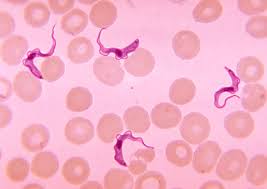Human African Trypanosomiasis:

In a landmark achievement, Chad has become the first country in 2024 and the 51st globally to eliminate a neglected tropical disease (NTD) — the gambiense form of human African trypanosomiasis (HAT).
- Human African Trypanosomiasis (HAT) is also known as sleeping sickness.
- It is caused by protozoan parasites transmitted by infected tsetse flies and endemic in sub-Saharan Africa.
- It takes 2 forms, depending on the subspecies of the infecting parasite:
- Trypanosoma brucei gambiense is found in 24 countries of west and central Africa, currently accounts for 92% of reported cases and causes a chronic illness.
- A person can be infected for months or even years without major signs or symptoms. When evident symptoms emerge, often the disease is advanced with the central nervous system already affected.
- Trypanosoma brucei rhodesiense is found in 13 countries of eastern and southern Africa, accounts for 8% of reported cases and causes an acute disease.
- First signs and symptoms emerge a few weeks or months after infection.
- The disease develops rapidly with multi-organ invasion, including the brain.
- Tsetse flies inhabit sub-Saharan Africa and only certain species transmit the disease.
- Rural populations which depend on agriculture, fishing, animal husbandry or hunting are the most exposed.
- To date, WHO has validated the elimination of the gambiense form of HAT in seven countries: Togo (2020), Benin (2021), Ivory Coast (2021), Uganda (2022), Equatorial Guinea (2022), Ghana (2023) and Chad (2024).




